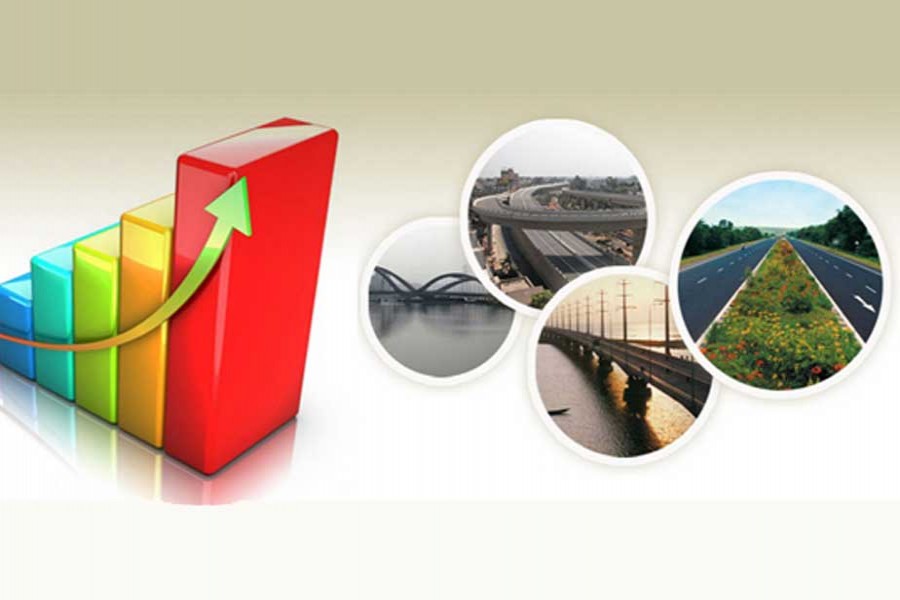The final estimate of the country's Gross Domestic Product (GDP) showed that the size of the economy crossed Tk 10-trillion mark in the past fiscal year (FY18). The GDP (at constant price) stood at Tk 10.22 trillion in FY18 recording 7.86 per cent growth over the previous fiscal's GDP worth Tk 9.48 trillion. The growth rate outpaced the rate of 7.40 per cent, projected in the Seventh Five-Year Plan (7FYP).
The growth trend reflects that Bangladesh has managed to grow reasonably fast despite a number of domestic odds. Widespread corruption is known as the major barrier to balanced development of the country. Nevertheless, the policymakers do often uncritically celebrate the persistent economic growth as a big achievement.
A new growth projection made by the HSBC Global Research would only elate their mood further. The global banking and financial services giant, in its latest research report titled 'The World in 2030', said Bangladesh would be the only country to maintain 7-plus growth rate annually up to 2030 and even beyond. The report discussed the future growth paths of the current 75 top economies of the world. It also showed that Bangladesh would become the 26th largest economy of the world in 2030 which is now 42nd in terms of GDP. Though the projection is based on a number of assumptions, this is a very optimistic reflection on Bangladesh economy, especially as regards GDP growth.
But GDP growth is not everything as thought of and preached by many in the country. Despite being an important indicator, it is not the only indicator of economic progress and socio-economic development.
The real strength of growth actually lies in its sources as well as its distribution patterns. The factors contributing to growth show its sustainability and the beneficiaries of growth reflect its quality.
For instance, a number of physical infrastructures like roads and bridges may be constructed with poor raw materials. The spending on the construction adds value to economy and contributes to expand the size. Due to poor construction, durability of the infrastructure is reduced, requiring repair works within a short time. Spending on the repair works again adds value in monetary terms which further contributes to GDP growth. In such a way, size of GDP may be increased which is reflected in the growth figure. It is, however, not sustainable in the long run. The ill-constructed infrastructures do not deliver the optimal benefits. Again, there is a big leakage of money which goes to a few people involved in the construction process. The growth of the economy thus benefits them exuberantly and disproportionately.
The simplified example shows that GDP data is neither a perfect nor a satisfactory measure of economic wellbeing. Policymakers should be aware of the fact. Still they apparently consider higher rate of growth as the ultimate success of the government's policies and development works. The development plan is designed to promote and achieve higher growth rate at the expense of quality of growth. So the 7FYP of Bangladesh sets 'GDP growth acceleration' as the first and foremost goal.
That high growth alone is not sufficient in many cases has been demonstrated by a good number studies, including a few conducted by the World Bank (WB) and International Monetary Fund (IMF).
A working paper of the IMF in 2014 proposed a framework to measure the quality of growth in developing countries by suggesting a quality of growth index (QGI) for 93 developing nations. The paper showed that Bangladesh ranked 50 among these countries in this index made for 2005-11 period. The index considered two things: the intrinsic nature of growth or growth fundamentals and the social dimension of growth which represents the desired social outputs from growth.
Dhaka-based research organisation titled South Asian Network on Economic Modelling (SANEM) prepared a QGI for 156 countries including Bangladesh which showed that the country improved modestly in the ranking during 2000-2015. In 2000, Bangladesh was ranked 112 and lagged behind Pakistan, ranked 99. In 2015, Bangladesh ranked 106 moving up six notches, while Pakistan ranked 108 declining eight notches.
While 'inclusive growth' is a popular slogan, the country's policymakers are yet to pay adequate attention to quality of growth. But without 'good quality of growth', it is not possible to attain inclusive growth. The rise of the 'super wealthy', increasing income inequality, and spread of rent-seeking and crony capitalism distort the growth story of Bangladesh.
The HSBC projection also carries a warning: Bangladesh is the second most vulnerable country in terms of climate change and environmental degradation in the next one decade.
GDP and its growth figure are sometime misleading. Increasing growth doesn't necessarily represent quality growth.


